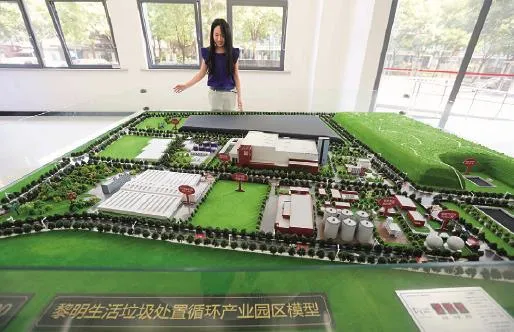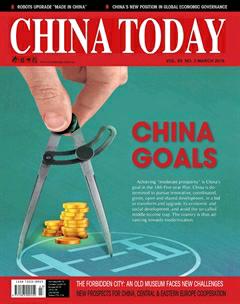Build a Green China
By staff reporter LI WUZHOU
Build a Green China
By staff reporter LI WUZHOU
TO residents of Ansai County in northern Shaanxi Province, the waist drum dance is a traditional and rousing performance art form. Performers clad in sheepskin waistcoats, their heads bound in white toweling, swirl red silk ribbons as they dance to thunderous drumming. However, in recent years the show has for many lost its dynamism, because the stage backdrop has changed from that of a yellow loess plateau to verdant green hills. The absence of the traditional yellow soil landscape has somehow neutralized the drama of the performance. To restore its authenticity, the county government has had no choice but to move the stage to a more traditional loess setting.
This story is just one manifestation of China’s expanded greening.

Visitors to Shanwangping Karst National Ecological Park in Chongqing kick back under forest shade.
Going Green
China is a time-honored agricultural country. However, due to excessive land reclamation and deforestation, in 1949, the year of the founding of the People’s Republic of China, the densely populated country had a scant 8.6 percent forest coverage.
Deforestation is a longstanding problem. Successive leaders of China since Chairman Mao Zedong have advocatedthe importance of afforestation for more than half a century, and practiced what they preached by planting trees. In the 1980s, China declared March 12 as Treeplanting Day, so establishing a lasting national tree planting movement. Statistics show that 13.3 billion person-times have planted 61.4 billion trees over the past 50 years.
Xu Gaoliu, a farmer from Nanchang County in Jiangxi Province, is an outstanding representative of these millions. Over the past three decades, he has planted more than 800,000 trees in his hometown.
The Elion Group has over a 40-year period created a 6,000-sq-km oasis in Kubuqi Desert, Inner Mongolia. Equivalent to 1/7000 of total global desertification, the area presents to the world an example of reproducible desertification control.
Since 1979, the 70-year large-scale Three-North Forest Shelterbelt Program in northwest, north and northeast China has afforested more than 20 million hectares of land, equal to one seventh of the world’s total artificial afforestation areas.

The scale model of the ecological industry demonstration park developed by Shanghai Pudong Environmental Protection Development Co., Ltd.
Since the onset of the new century, China has unveiled a number of related policies. They include the “grain for green” policy of 2002, reform of the forestry property rights system in 2010, and reverting grain plots to forestry in 2012. So far, about 24.3 million hectares of land have been cultivated into forests.
Recent years have witnessed boundless enthusiasm for the building of forest parks around the country. Guangdong plans to build more than 1,000 such parks within three years, and Ningxia to build at least one forest park in each county. Shanxi, meanwhile, is promoting the construction of 100 parks in 100 counties. By the end of 2014, China owned about 3,000 forest parks, 800 of which are national forest parks.
However, the world’s forested areas are shrinking at the rate of 6.7 million hectares per year. Despite enormous ecological pressure as a result of sustained and rapid economic growth, China has realized growth in terms of both forested areas and forest stock volume. Especially in 2013 and 2014, China maintained six million hectares of afforested areas. By the end of 2014, China’s 69 million hectares of man-made forest had earned it a number one world ranking.
Global vegetation coverage has risen in recent years, according to an analysis of satellite data over 20 years by the University of New South Wales, Australia. A major reason for this is that China’s long-term large-scale afforestation has expanded its vegetation cover. A UN Food and Agriculture Organization report also mentions China’s substantive contribution to reversing the trend of reduced world forest resources.
China’s forested areas stand at 208 million hectares, an increased coverage of 21.63 percent, according to the latest national forest resource inventory.
Green Development
In March 2015, China raised a new strategic greenization target in efforts to promote a green production mode and achieve a green lifestyle.
The concept of greenization imbues far more than afforestation because it refers to a change in the eco-friendly development pattern. With ecological advancement at the core, it will bring about global optimization of politics, economy, culture, and society.
Although the country has achieved amazing results from afforestation, it cannot counteract the ever-worsening ecological environment resulting from the extensive production mode. Food safety, water security, and air quality are now crucial issues.
China’s economic development since reform and opening-up came into effect is attributable to its labor-intensive industry that produces and sells cheap manufactured goods to the world. The country’s endeavors to prosper motivated it to follow the suit of developed countries in adopting the highly pollutant, high energy consumption mode of industry that has contaminated its water, air, and soil. The haze over China’s northern and eastern metropolises reflects this high energy consumption/lax management dichotomy.
China has been through a process of understanding and exploration in its moves to change the country’s economic development mode. In September 1995, China proposed transforming its economic pattern from one of extensive to intensive economy. In 2005, the country made the proposal to form a conservation-minded society featuring low input, low consumption, low emissions, and high efficiency. In 2007 Chinaraised the concept of ecological progress, with the strategic mission of transforming its economic development mode, so highlighting China’s more rational and mature development concept in the 21st century.
In 2012 China proposed building a“beautiful China” by prioritizing the“ecological progress” in the overall development plan; one in parallel with the economic, political, cultural, and social construction. The goal of sustainable development and building a livable environment for the people might thus be achieved.
With this in mind, China has done its utmost to improve rules and laws on environmental protection. The country has indeed encouraged science and technology innovations and the transformation of modes of economic growth by advocating a green consumption path. China’s resolve to combat environmental pollution is thus manifest.
China has adopted various macro adjustment and control methods of eliminating outdated capacity. They include curbing environmentally polluting, high energy consumption industrial projects, promoting development of new energy, and improving projects that generate high emissions, according to Professor Cai Shouqiu, chairman of Chinese Society of Environment and Resources Law. Cai said that China has applied to companies whose production methods cause serious pollution the policies of shutting down or suspending their operations, or amalgamating them with other companies.
Moreover, China has fundamentally formed its law system aimed at pollution prevention and control and environmental protection. It includes laws on protecting marine environment, and air and water pollution prevention and control, and also various laws that promote cleaner production, circular economy and natural resources conservation.
These efforts have achieved good results. In the past five years, China has eliminated the outdated production capacity of 100 million tons of steel, 560 million tons of coal, and 400 million tons of cement. In 2014, China’s energy consumption per unit of GDP dropped by 29.9 percent and its carbon dioxide emissions by 33.8 percent of the 2005 levels, according to Zhao Baige, member of National Expert Committee on Climate Change. The target of a 17 percent reduction of 2010 levels of carbon dioxide emissions per unit of GDP by 2015 has been achieved. China is now the world’s largest country as regards energy conservation and utilization of new and renewable energy.
Statistics cited by Professor Cao Mingde of China University of Political Science and Law show that China’s energy productivity has improved from RMB 1,891.3 per tonne of coal equivalent (TCE) in 1990 to RMB 14,792.2 per TCE. The energy intensity gap between China and developed countries is gradually narrowing.
Green Lifestyle
Although many Chinese people do not completely comprehend what “going green” entails, they recognize and are agreeable to the green lifestyle that various government departments and civil societal organizations have promoted over the past few years. Green commuting, green consumption, and green furniture are indeed the latest trends.
License plates in traffic-jam fraught cities must be obtained through a lottery or auction system. Purchasers of new energy cars, however, are not only exempted from such restrictions, but also enjoy government subsidies. China is consequently the world’s biggest market for new-energy vehicles. In 2015, more than 300,000 new-energy vehicles were sold in China, accounting for more than 30 percent of the total global sales volume.
Owing to road conditions and income levels, electric bicycles and tricycles are most popular with Chinese people. In 2015, a total of 22 million electric bicycles and eight million electric tricycles were sold in China. However, many people still prefer the bog-standard pushbike, due to the health benefits to be gained from self-generated mobile energy.
Policies, including that whereby Beijing residents enjoy subsidies of eight to 20 percent of the retail price when buying energy-saving appliances, encourage manufacturers to improve and make home appliances more energy-efficient.
In addition to the government’s efforts, many culture, arts, film and TV, and sports celebrities also make their due contribution. Some social organizations hold various activities that show how to calculate a carbon footprint, and how emission quota can be traded on carbon emission markets.
Chinese people today, especially urban residents, have an enhanced awareness of green lifestyle. Many consumers take bags with them to supermarkets or other retail outlets, to avoid excessive use of plastic bags. People who often go on business trips bring their own toiletries rather than using those supplied at hotels. And more and more people choose energy-saving lamps, even though they are considerably more expensive than ordinary ones.
In some residential communities, volunteers collect unwanted used clothing and books and donate them to people in poverty-stricken areas. Schoolchildren who have learned about the green lifestyle in class often urge other family members to conserve water and energy. Li Mengchu, born into a middle-class family in Shanghai, plays in an orchestra. She declines to let either of her parents drive her to rehearsals in the family car, preferring instead to travel with her cello on the bus. She told China Today that many of her friends do the same.
When visiting a low-carbon residential community in Wuhan City, China Today was surprised to see that some residents even used the accumulated oil under the range hood to make soap.

